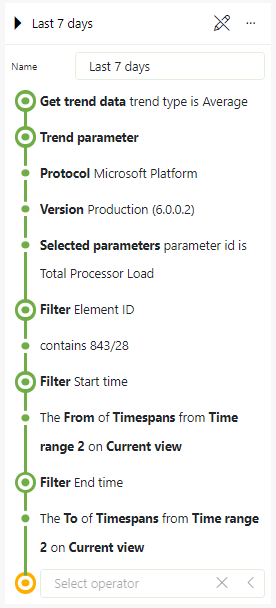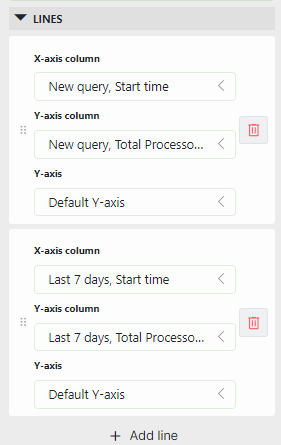In dataminer I have a table column parameter that has enabled real time and average trending.
The real time data has configured to 24 hours.
In my dashboard, I am displaying a line and area chart of the parameter so that user can see the trending of the graph.
My questions is: Is it possible to have the chart showing 24 hours real time value combine with average value before the 24 hour?
Currently I have the chart settings Trend points – real time. And the chart shows real time accurately. However, the user is also allowed to change the timespan to monitor longer history values. But when change the timespan to more than 24 hours the chart shows no result.
Is there a way I can combine real time value and average value for a single column parameter in 1 chart?
Chart left shows average value, chart right shows real time value (both with timespan of last 7 days)

Hi Zhing Hang,
Unfortunately this cannot be done using a parameter as data in the line chart component. This configuration can be achieved using the same component with queries starting from DataMiner 10.3.0[CU15]/10.4.0[CU3]/10.4.6 onwards.
First you will need 2 time range components to use as a feed in your queries.
- One with default range ‘last 24 hours’
- One with default range ‘last 7 days’
Then you can create 2 queries that each fetch part of the data using the ‘Get trend data’ source.
- One with real-time date & the time filtered on the ‘To’ and ‘From’ feeds of the first time range
- One with average date & the time filtered on the ‘To’ and ‘From’ feeds of the second time range

These queries can then be added to the line chart component and 2 lines can be configured. The first line will show the real-time data for the last 24 hours. the other line will show the average data for the last 7 days. Note that these lines will overlap since there is no ‘Last 7 days – last 24 hours’ option in the time range component. The colors of the lines can be configured using the color palette of the component/dashboard.

In the end, you will get a dashboard like this:

Alternatively, you could create an ad hoc data source that returns the desired points. This way, there is no need for the time range components & the 2 lines will not overlap. The ad hoc source can also define an input argument for the parameter that can be linked to a feed, which the built in ‘get trend data’ source cannot do.